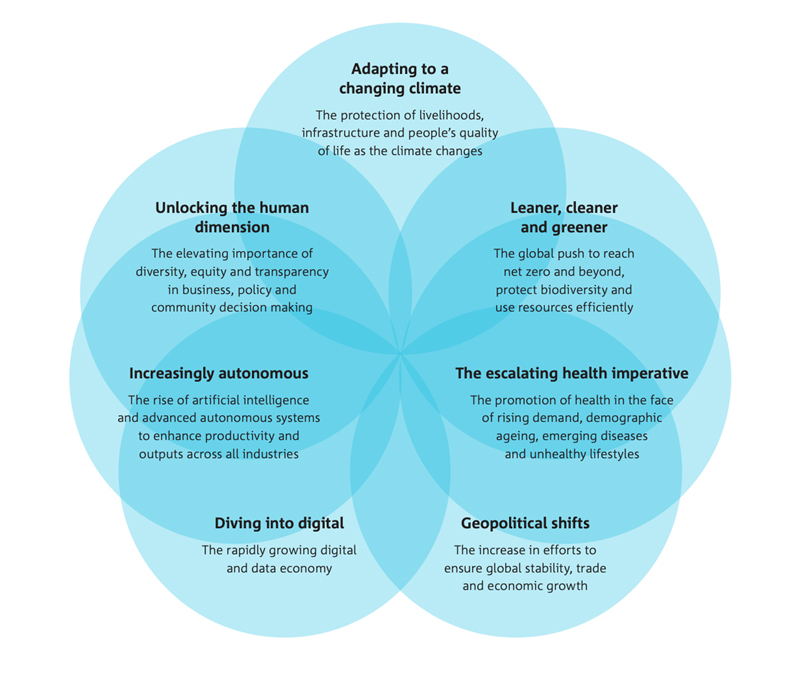These megatrends will shape Australia’s future

Ten years ago, CSIRO released a landmark report looking at “global megatrends” that would shape people around the world in the years that followed.
In July 2022, CSIRO revisited the idea. In a report dubbed Our Future World, the organisation crowned seven new megatrends that will affect the direction of our lives.
Some of the projections have predictably come to pass: biodiversity is ever-dwindling; we are more reliant on the virtual world to communicate; populations in developed countries are rapidly ageing; and the focus of the world economy is shifting from west to east.
But others could barely have been guessed at in 2012: geopolitical tensions are increasing, countries are pulling apart and away from one another, and a pandemic has challenged many of our assumptions about how the world operates.
“Australia is at a pivotal point. There’s a tidal wave of disruption on the way, and it’s critical we take steps now to get ahead of it,” CSIRO chief executive Dr Larry Marshall told the media when the report was released.
“From resource scarcity to drug-resistant superbugs, disrupted global trade, and an increasingly unstable climate threatening our health and way of life – these are just some of the challenges we face. But these challenges also tell us where the most powerful innovation can be found, when we see a different future and leverage science to create it.”

For example, the “adapting to a changing climate” trend obviously represents an existential crisis. But there is also huge potential, because the world is crying out for renewable energy and Australia has one of the largest, sun-drenched landmasses and coastlines in the world, making us ripe for investment in solar and wind power to export overseas.
Similarly, the “diving into digital” trend explores the rapid increase in uptake of digital and data technologies – such as online shopping, remote working, telehealth, online education and digital currencies – due to the COVID pandemic. But it predicts a huge opportunity if Australia can position itself now, because we are only at the tip of the digitisation iceberg.
Although ageing populations were already sending us in this direction, the pandemic has resulted in a new focus on “the escalating health imperative”, with an intensification of health challenges and a massive increase in health expenditure, but also possible opportunities presented by preventative health measures and precision medicine.
“Geopolitical shifts” sees disruptions in patterns of global trade and security, and burgeoning expenditure on defence, which has again been exacerbated by COVID and a greater realisation of the threat posed by future pandemics, as well as the impacts of climate change and population growth.
Those pressures are sending us into a world where we must learn to be “leaner, cleaner and greener” and transition to a carbon-neutral economy if we want to survive, as the world’s populations develop and the demand for food, water, resources and energy ever expands.
Concurrent with development is a shift to an “increasingly autonomous” world. As breakthroughs in artificial intelligence and robotics see manufacturing, industry and many other sectors shrinking their workforces, it has the potential to free people from drudgery, boost productivity and work towards solving some of humanity’s greatest challenges.
Finally, emerging social trends are “unlocking the human dimension” as consumers demand increasing transparency and agency to make their own choices related to purchases, jobs, businesses and government policies.
“Trust emerged as a central theme,” CSIRO’s Dr Claire Naughtin said in July. “Trust in institutions, technology, supply chains and security will all be key issues.”
She added that we can use these megatrends to focus the efforts of Australia’s governance and economy. Much as wind tunnels are used to test the durability of aircraft, “we can use these megatrends to develop, test and refine future strategies to ensure they are robust, whatever the future holds”, she said.




